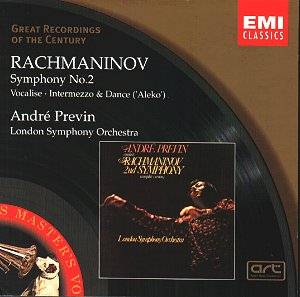
This was a hallmark recording in 1973 in that the symphony was played in
its complete version without the disfiguring cuts that even Rachmaninov had
sanctioned (although according to Previn he only really approved a small
cut in the finale - in a previous LSO recording for RCA LSO Previn had made
all the usual cuts). It makes for a long work (nearly an hour) and that has
been said to be too long for a composer of such limited ability. Well I think
I can answer that simply by pointing to Schubert's 9th symphony or Elgar's
second without having to invoke Mahler or Bruckner. What matter is not the
length but the invention. The reference to limited ability is that Rachmaninov
appeared to constantly worked mine the same vein without ever developing
and it was surely the Previn series of Rachmaninov recordings that helped
to dispel that belief too, followed eventually by a re-evaluation in the
more louring Ashkenazy series for Decca which reached a peak with his performance
of the Isle of the Dead.
Previn and the LSO were at their peak and had toured this symphony
internationally before setting it on record. Previn has said 'one of the
most unforgettable events of my musical life was seeing members of the Moscow
audience, openly and unabashedly weeping during the performance. After the
concert had ended, the orchestra and I came out of the stage door into the
icy street, where people were still waiting for us. A young woman came forward,
and , in a mixture of broken English and French, thanked us for the Rachmaninov.
Then she gave me a gift, a token of her gratitude to Rachmaninov: one orange,
for which she had, without a doubt, queued quite a time that afternoon.'
Rachmaninov writes a good tune and all praise to him. He also writes orgasmically
for soaring and cascading strings and it might be the association with Mantovani
that causes critics to sneer. A composer of good tunes who is 'Popular' will
never do and those Paganini Variations!. Well, of course, I am playing the
Devil's advocate because I love Rachmaninov. He is not only the ultimate
romantic composer but can also be extraordinarily powerful (Isle of the Dead
or the Symphonic Dances). To me his appeal is limitless rather than limited
and I look back with nostalgia at this recording. It is well known that
Rachmaninov's first symphony was a disaster at its first performance and
instituted a creative block in the composer that lasted several years until
his confidence was restored by the success of his second Piano concerto.
The second symphony was completed in 1907; 12 years after the first and found
the appreciation he craved.
From the very opening one is immediately aware of the performance Previn
will produce. The symphony opens with a motto theme in the double basses
and cellos that occurs throughout the symphony making it a unified whole.
Violins and woodwinds have two more motto themes and they all play an important
part in all movements of the symphony. Straight away we are into those swaying,
cascading strings that remain for ever in the memory. Not that many symphonies
have such a memorable opening, one that immediately makes one want to dance
and to sing. It is important not to rush this and Previn's gently elongated
approach serves Rachmaninov well (in the later Telarc recording Previn takes
even longer over this movement). There is a feeling of one-ness between orchestra
and conductor which is the hallmark of a great recording. But it is surely
the adagio that will convert the listener with Jack Brymer's clarinet weaving
a hypnotic melody over lush strings that will eventually soar into a very
Tchaikovskian climax
The symphony has appeared in different formats on CD. Its initial CD release
was a Japanese-Toshiba pressing and was greeted with horror by Ivan March
who complained that the warm opulence of the strings had become dehydrated
and even shrill, quite unlike the original LP sound. I was particularly
interested to hear this re-mastered CD in the Great recordings of the Century
series because I posses that original Japanese CD pressing. I undertook a
comparative listening session with interesting results. In spite of laudatory
comments in the past I suspect that this never was a particularly good recording
and EMI's engineers have had to struggle with it ever since. The sound is
hard as if the microphones were placed too close, particularly to the strings.
The new CD is cut at a higher level than the Japanese pressing which constitutes
a problem when trying to switch between the two for comparative purposes.
There is tape hiss and this has become more obvious in the remastering in
spite of "Abbey Road Technology". The bass is firm and the string sound is
definitely warmer in the original in spite of Ivan March bemoaning a loss
of warmth. What would he think of the remastered version where the basses
are drier and the strings have acquired a buzzy edge? But all is not in favour
of the Japanese pressing because the louder passages are definitely less
congested in the remastered version, probably to do with sucking out the
bass. So not a total success and I suspect we will have to wait for one of
the audiophile companies to obtain the rights to this tape to hear it reveal
its true qualities.
Nevertheless the performance is overpoweringly convincing and worth every
penny of the mid-price demanded. A further advantage of the reissue is that
the symphony is now joined by Vocalise and the Intermezzo and Women's Dance
from Aleko making a very full disc.
Reviewer
Len Mullenger
Performance 
Recording 
Equipment used: Audiolab 8000CDM CD transport, Meridian 518DAC, Chord DSC900
converter, Chord SPM1200B amplifier, B&W 802 speakers with appropriate
interconnects.
